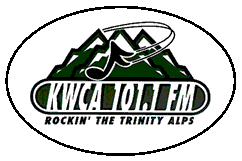Wildfire Awareness Week
May 10-16, 2004
The Trinity County Fire Safe Council is active in promoting defensible space and fire prevention throughout the year, but Wildfire Awareness Week is when we really need residents’ help---before fire season starts. Protect Your Home, Your Property, and Your Community from Wildfire.
- Properly maintain all outdoor plants by regularly removing dead branches, leaves and needles
- Create a "defensible space" around your home by removing all flammable vegetation at least 30 feet and replacing it with fire resistant plants
- Clear away flammable vegetation within 10 feet of all woodpiles
- Post your house address at the beginning of the driveway, or on the house where it is EASILY visible from the road
Defensible Space is YOUR Responsibility!!
|
District Manager's Corner
by Pat Frost
When I came to the District in 1999 one of the first things I received was a two-page list of terms that I would need to know to do my job. Every field of work has its own set of words – plumbers and carpenters talk in terms that may seem foreign to those of us who aren’t involved in construction every day.
Those of us working in conservation also have a vocabulary that is specific to our work, and it is easy for us to forget that not everyone will have a working knowledge of these words, known as jargon. I was reminded of this recently when I sat down in front of the microphone in the studio at the KWCA radio station in Weaverville to begin an interview about the District. I had to think about wildfire prevention and the health of our streams in terms that the listeners would understand, not in the terms that a forester or a fisheries biologist would use.
The Conservation Almanac is much the same as that radio broadcast. We have to think about what we say and how we say it. Sometimes there is no alternative word for a scientific term. So, starting with this issue, we will include some definitions or at least our way of describing some of these technical terms. This issue has some interesting stories about the restoration of the Trinity River and we’ll start there with the way I try to understand some of these terms.
Hydrograph: You’ll find a graph in Article 1 that shows how the Bureau of Reclamation will release water from Lewiston dam. It shows amounts of water flowing down the river between May and July. So you can think of a hydrograph as just that – the change in the amounts of water in a stream over a period of time.
Cubic feet per second (cfs): Think of yourself standing on the bank of a stream that is one foot wide and one foot deep and visualize that volume of water or a box that is one foot on each side that travels past you ever second. One cubic foot of water is 7.5 gallons of water.
Acre-foot: This is another way to look at a volume of water. A parcel of land that is about 208 feet square with one foot of water covering that parcel would be 1 acre-foot. 1 acre-foot of water is about 326,000 gallons.
Riparian: This word refers to stream banks and usually is used when talking about the plants that grow along the edges of streams – plants like willows, alders and cottonwoods and the animals that live amongst those plants.
I hope you enjoy this issue of the Conservation Almanac and let us know how we can improve our newsletter. You can reach us at 530-623-6004.

|


